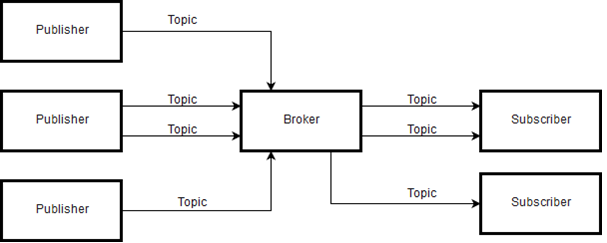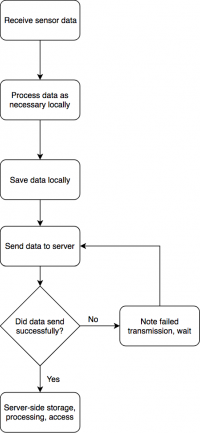Projects:2018s1-111 IoT Connectivity Investigation
Contents
Project Team
Sponsor
Soniclean Pty. Ltd.
Honours Students
Edward Gray
Jack Mansfield
Supervisor
Dr. Andrew Allison
Paul Clarke (Soniclean)
Introduction
As computers and network connectivity has become cheaper, more and more devices have been connected to the internet for a wide variety of purposes. These devices which are not used by a human in the way a traditional computer is are known as the "Internet of Things" (IoT.)
This project is sponsored by Soniclean Pty Ltd. "Soniclean® is amongst the world's foremost manufacturers of innovative medical grade ultrasonic cleaners, with over two decades of leadership experience in the ultrasonic industry. Soniclean® ultrasonic cleaners provide a faster, safer alternative to conventional cleaning methods and, using Soniclean's unique Pulse Swept Power® technology, give a superior cleaning performance."[1]
This project seeks to add IoT capability to Soniclean’s ultrasonic cleaning machines to enable new monitoring and auditing functionality. The project aims to develop a system to enable Soniclean's ultrasonic cleaning machines to report their operational status from all over the world back to a central server. From there, the data can be analyzed to determine if a cleaner is in need of repair, or to confirm that a given machine is in good working order. While there are IoT solutions commercially available on the market, Soniclean has determined that they need at least a partially custom solution as they have a unique set of requirements.
Abstract
To meet requirements outlined by Soniclean, we develop a prototype device on top of the existing and widely available Raspberry Pi hardware platform and the MQTT (Message Queuing Telemetry Transport) IoT data transmission protocol that will collect data from sensors embedded within Soniclean’s ultrasonic cleaners all over the world and send that data to a central server operated by Soniclean. This will enable Soniclean to offer new auditing and monitoring services for their products and thus grow their business.
We do not implement sensor or back end server systems, that being the responsibility of Soniclean. We only develop a means to collect sensor data and transmit that data back to Soniclean, and an example server that receives that transmitted data and allows for further data analysis.
Background
About Ultrasonic Cleaning
The operation of Ultrasonic cleaners is not relevant to the rest of this project, except as context for why Soniclean seeks to measure and report the particular parameters on their machines.
In ultrasonic cleaning, items to be cleaned are placed in a solvent bath of mildly alkaline water. Transducers then blast sound waves through this bath at frequencies above human hearing, hence ultrasonic cleaning. These high frequency, high intensity sound waves cause cavitation- at the trough of the sound wave, there is a region of low pressure, which causes the solution to boil, forming a bubble. As the wave moves on, to it causes this bubble to compress with great force- over 20,000 PSI. This forcefully removes any contaminants from the surface of the objects being cleaned on a microscopic level.[2]
The biggest market for Soniclean's Ultrasonic cleaners is in the medical field.
System Design
System Overview
A high level overview of the system is shown below. Sensors (yellow) collect data on the performance of the Ultrasonic cleaner. The compute system (green) collects that data, performs any required processing and saves that data locally. It then sends the data off across the Internet (blue) to the Soniclean server (red.) This scope of this project is only getting data from Soniclean's sensors to a testing server.
Hardware
Compute Platform
To meet the needs of this project, a computing platform is required to be able to acquire, process, store and transmit sensor data. There are a number of requirements for whatever platform this system is to use, outlined below:
• The platform shall be low cost, to allow for adaption to economic use at scale
• The platform shall be widely available, to allow for adaption to use at scale
• The platform shall be well supported, both to assist in development and usage
• The platform shall have the required I/O- connectivity to a cellular modem and the ultrasonic cleaner (RS-485 serial)
• The device shall have local storage
Considering, these requirements, and on recommendation from Soniclean, the Raspberry Pi 3 Model B was selected as the computing platform for this project. The Raspberry Pi is available for US $35 globally, has rich I/O including GPIO, UART, SPI, I2C, USB, Ethernet, WiFi, Bluetooth and having sold millions of units, has a broad and active community forum.
The Raspberry Pi also runs a full Linux environment, which makes developing one device very easy, making software development fast and simple. Storage on the Raspberry Pi is provided by a micro SD card, which can provide many gigabytes of storage for low prices, allowing for storage of many log files locally.
Networking Hardware
Modem hardware is required to communicate with the local cellular network to give the device internet access. The requirements for this are outlined below.
• The modem shall support multiple frequencies for worldwide operation
• The modem shall support for 3G networks
• The modem should have a reasonable cost
• The modem shall be software and hardware compatible with the Raspberry Pi
• The modem shall have support for an external antenna
Considering these requirements, we have selected the Hologram Nova[3]. The Nova advertises compatibility with Linux and the Raspberry Pi, supports quad band 3G for worldwide operation, has a u.FL connector for an external antenna and can be bought for around $100.
The Nova also comes with 2 antennas saves the hassle of buying an antenna separately.
Ultrasonic Cleaner
We have been provided with a development unit ultrasonic cleaner model 800D by Soniclean for the purpose of completing this project. This unit does not have a cleaning chamber or ultrasonic driver and is therefore not functional, but all the electronics are present allowing for this project to be completed. The model is a desktop model, meaning it is easy to transport and does not take up an excessive amount of bench space.
A Soniclean Ultrasonic cleaner[4]
Other Hardware
This project requires minimal other hardware. We use the RS-485 Shield V3 by Linksprite [5] to convert the ultrasonic cleaners RS-485 output to UART serial which the Raspberry Pi can accept as an input.
Software
Python
That software in this project is written in the Python programming language. We chose to use Python as Python has in built code for most common functions, including good support for third party applications and for its high level nature, allowing complex code to be written in relatively few lines of code.
We also chose Python as we have prior experience with the language, and wish to avoid having to learn a new language.
Python is also well supported on the Raspberry Pi, with many forum topics about the language.
MQTT
A protocol is sought to do much of the low level work to handle network communications in the system without coding an implementations from scratch. The protocol would ideally meet the following requirements:
• The protocol shall be able to reliably handle communications from one node to another across the internet with minimal additional coding
• The protocol shall have good documentation
• The protocol shall have good Python libraries and, if required good Linux tools
• The protocol shall be able to run on the Raspberry Pi
• The protocol shall be able to operate with limited network bandwidth and data usage
• The protocol shall be open source or otherwise free
Research was conducted and the Message Queueing Telemetry Transport protocol (MQTT) was identified as meeting all these requirements. MQTT is an ISO standard support by the OASIS consortium, designed as “an extremely lightweight publish/subscribe messaging transport. It is useful for connections with remote locations where a small code footprint is required and/or network bandwidth is at a premium. For example, it has been used in sensors communicating to a broker via satellite link, over occasional dial-up connections with healthcare providers, and in a range of home automation and small device scenarios. It is also ideal for mobile applications because of its small size, low power usage, minimised data packets, and efficient distribution of information to one or many receivers.”[6]
MQTT uses as publisher-subscriber model, with a broker acting as an intermediary, shown in the figure below
Publishers send data to a broker, and subscribers receiver data from a broker, meaning the only thing about the network an individual device must know is the broker. We use Mosquitto as the broker in this system. Mosquitto is open source software from the Eclipse foundation.[7]
To talk to the Mosquitto broker, we use the Python module Paho-MQTT, also open source and by Eclipse.[8] This allows us to write a Python program to send messages to our Mosquitto broker, and then another Python program to receive messages from the broker. This second program can be run on the same computer as the broker, meaning there are only two physical computing devices involved.
MQTT also breaks down communications into topics, which allow for the separation of unrelated data, or to allow an individual device to send different data to different other devices on the network.
Overview of operation of the system software
The following diagram provides a visual representation of the flow of the cleaning cycle data through the system. It begins at the serial interface with the system and ends at the saving of logs on the server.
1. Receive sensor data: Sensor data is captured by the Raspberry Pi through the RS-485 interface.
2. Process Data: The data is processed locally to combine all the data associated with one cleaning cycle.
3. Save Data Locally: The data is saved locally.
4. Send Data to Server: Data is sent to the server using MQTT's publish command. We publish to the 'Data' topic.
5. Did Data Send Successfully?: We check whether data was successfully sent, verified by acknowledgement from the server. This is a built in feature of MQTT.
6. Data Did Not Send: If the data did not send, the system notes this failure. It then re-attempts the sending.
7. Successful Send: When data is sent successfully it is collated on the server in CSV format. This provides access to Soniclean who can now audit the data.
Testing
Final System Developed
We have developed and demonstrated a system that can perform the following tasks
• Interface with a Soniclean ultrasonic cleaner over RS-485 serial and receive data sent by the cleaner
• Locally save data received from the cleaner
• Encrypt and send data received from the cleaner over the internet using the MQTT protocol
• Confirm that all data is correctly sent, even if a power loss or network outage is sustained
• Receive data sent over the internet from cleaners at a server, which can talk to multiple cleaners and format and display data received
Further Work
does this work?



